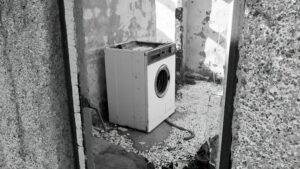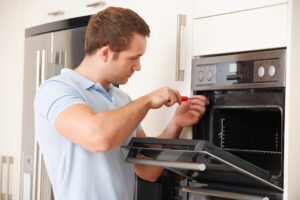Key Takeaways
- Unplugging appliances before working on them is crucial for safety
- Working on appliances without unplugging can lead to electric shock or fire
- Basic safety measures include wearing protective gear and using insulated tools
- Properly unplug appliances by pulling the plug, not the cord
- Only work on appliances that are not unplugged if you are a trained professional with the proper equipment
Why is it important to unplug appliances before working on them?
Unplugging appliances before working on them is crucial for several reasons. First and foremost, it eliminates the risk of electrical shock. Appliances are powered by electricity, and when they are plugged in, they carry a current that can be dangerous if not handled properly. By unplugging the appliance, you remove the source of electricity and reduce the risk of electrocution. In addition to electrical shock, leaving appliances plugged in while working on them can also pose a fire hazard. Faulty wiring or damaged components can cause sparks or overheating, which can lead to a fire if not addressed promptly. By unplugging the appliance, you eliminate the possibility of an electrical fire starting while you are working on it.Common risks associated with working on appliances without unplugging
Working on appliances without unplugging them can result in various accidents and risks. One of the most significant dangers is electrical shock. When an appliance is still plugged in, it continues to carry an electrical current that can be transmitted through your body if you come into contact with live wires or components. This can lead to severe injuries or even death. Another risk is fire hazards. Appliances that are still plugged in can have faulty wiring or damaged components that can cause sparks or overheating. If you are working on the appliance without unplugging it, you may inadvertently trigger a fire, putting yourself and your property at risk. Furthermore, working on appliances without unplugging them can also cause damage to the appliance itself. When you are repairing or replacing parts, there is a risk of accidentally causing further damage if the appliance is still connected to a power source. Unplugging the appliance ensures that you can work on it without the risk of causing additional harm.Basic safety measures to take before working on appliances
Before starting any repair work on an appliance, it is essential to take some basic safety measures to ensure your well-being. First and foremost, always wear protective gear. This includes safety goggles to protect your eyes from debris or sparks, gloves to protect your hands from sharp edges or electrical shocks, and non-slip shoes to prevent accidents caused by slipping or tripping. Another crucial step is to turn off the power source. This can be done by unplugging the appliance from the wall socket or switching off the circuit breaker that supplies power to the appliance. By doing so, you eliminate the risk of electrical shock and reduce the chances of a fire hazard. Additionally, it is important to use insulated tools when working on appliances. Insulated tools have handles made of non-conductive materials such as rubber or plastic, which provide an extra layer of protection against electrical shock. Using insulated tools minimizes the risk of accidentally coming into contact with live wires or components.How to properly unplug appliances
Unplugging an appliance before working on it is a simple process that can be done by following a few steps: 1. Locate the power cord: Identify where the power cord is connected to the appliance. It is usually located at the back or bottom of the appliance. 2. Switch off the appliance: If there is an on/off switch on the appliance, turn it off before unplugging it. 3. Unplug from the wall socket: Firmly grasp the plug and pull it out of the wall socket. Avoid pulling on the cord itself, as this can damage the cord or the plug. 4. Confirm power is off: Before starting any repair work, double-check that the appliance is no longer receiving power. You can do this by attempting to turn on the appliance or using a voltage tester to check for any electrical current. By following these steps, you can ensure that the appliance is safely disconnected from the power source before beginning any repair work.When is it safe to work on appliances that are not unplugged?
While it is generally recommended to unplug appliances before working on them, there are some situations where it may be safe to work on appliances that are still plugged in. One such scenario is when you are performing visual inspections or minor adjustments that do not require direct contact with electrical components. For example, if you are inspecting the exterior of a refrigerator for any visible damage or checking the control panel of a dishwasher for loose connections, you may not need to unplug the appliance. However, it is still important to exercise caution and avoid touching any exposed wires or components. It is important to note that even in these situations, it is still advisable to unplug the appliance if you are unsure about the extent of the repair work or if you need to access internal components. It is always better to err on the side of caution and prioritize safety.Tools and equipment needed for safe appliance repair
To safely work on appliances, it is essential to have the right tools and equipment. Here is a list of some essential items: 1. Insulated screwdrivers: These screwdrivers have handles made of non-conductive materials and are designed to minimize the risk of electrical shock. 2. Voltage tester: A voltage tester is used to check if an electrical circuit is live or not. It can help ensure that an appliance is safely disconnected from the power source before starting any repair work. 3. Multimeter: A multimeter is a versatile tool that can measure voltage, current, and resistance. It is useful for troubleshooting electrical issues in appliances. 4. Insulated gloves: Insulated gloves provide an extra layer of protection against electrical shock when working on live circuits or components. 5. Wire strippers: Wire strippers are used to remove the insulation from electrical wires, allowing for proper connections or repairs. 6. Pliers: Pliers are versatile tools that can be used for gripping, bending, or cutting wires and other materials. 7. Flashlight: A flashlight is essential for illuminating dark areas inside appliances or for working in poorly lit spaces. Having these tools and equipment readily available will ensure that you can safely and effectively repair appliances without compromising your safety.How to identify and troubleshoot common appliance issues
Identifying and troubleshooting common appliance issues is an important skill for any DIY enthusiast or homeowner. Here are some tips on how to identify common appliance issues and troubleshoot them: 1. Start with visual inspection: Before diving into complex troubleshooting, start by visually inspecting the appliance for any visible damage or loose connections. Look for frayed wires, burnt components, or signs of overheating. 2. Check power supply: If the appliance is not turning on or functioning properly, check if it is receiving power. Ensure that it is plugged in correctly and that the circuit breaker has not tripped. 3. Consult the user manual: The user manual provided with the appliance often contains troubleshooting tips and solutions for common issues. Refer to the manual for guidance on specific problems. 4. Test components: Use a multimeter to test various components such as fuses, switches, motors, or heating elements to determine if they are functioning correctly. 5. Seek professional help if needed: If you are unable to identify or resolve the issue on your own, it is best to seek professional help. Attempting complex repairs without the necessary expertise can lead to further damage or safety hazards. By following these troubleshooting techniques, you can identify and resolve common appliance issues effectively.Tips for avoiding accidents when working on appliances
In addition to the basic safety measures mentioned earlier, here are some additional tips for avoiding accidents when working on appliances: 1. Disconnect from the power source: Always unplug the appliance before starting any repair work. Even if you believe the power is off, it is better to be safe and ensure that there is no electrical current flowing through the appliance. 2. Use proper lifting techniques: Appliances can be heavy and awkward to handle. Use proper lifting techniques to avoid strain or injury. If an appliance is too heavy, ask for assistance or use a dolly or lifting straps. 3. Keep a clean and organized workspace: A cluttered workspace can increase the risk of accidents or injuries. Keep your work area clean and organized, ensuring that tools and equipment are stored properly when not in use. 4. Avoid working alone: Whenever possible, have someone else present when working on appliances. They can provide assistance if needed and can also help in case of an emergency. 5. Take breaks: Repairing appliances can be physically demanding work. Take regular breaks to rest and hydrate to avoid fatigue or exhaustion, which can increase the risk of accidents. By following these additional safety tips, you can minimize the chances of accidents or injuries while working on appliances.The importance of prioritizing safety when working on appliances
In conclusion, safety should always be the top priority when working on appliances. Unplugging appliances before starting any repair work is crucial to eliminate the risk of electrical shock, fire hazards, and damage to the appliance itself. By following basic safety measures such as wearing protective gear, turning off the power source, and using insulated tools, you can ensure your well-being while working on appliances. Properly unplugging appliances involves a simple step-by-step process that should be followed to ensure safety. While there may be some situations where it is safe to work on appliances that are still plugged in, it is generally recommended to unplug the appliance to minimize risks. Having the right tools and equipment, as well as the knowledge to identify and troubleshoot common appliance issues, is essential for safe and effective repairs. By following these guidelines and tips, you can prioritize safety and avoid accidents when working on appliances.How Can I Safely Unplug and Disable Appliances for Maintenance?
When it comes to unplugging appliances for safety during maintenance, always make sure to turn off the power switch and pull the plug straight out from the outlet. Avoid yanking the cord to prevent any damage. It’s important to follow these steps to ensure a safe and smooth maintenance process.



